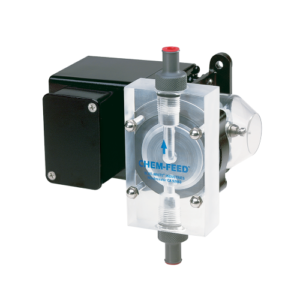A chemical metering pump is designed to move a specific amount of fluid within a specific period of time. You’ll hear this called dosing or metering, which is where the name comes from. Typically, metering pumps are used to distribute solutions and chemicals in various industries for many applications. There are many different variations and types of metering pumps available, such as diaphragm pumps or peristaltic pumps, so it can be difficult to select the right one for your needs. You need to take sizing, material, liquid ends, leak protection, and control systems into account.
Sizing Your Chemical Metering Pump
The sizing you choose for your metering pump matters. This consideration calls for identifying what your required capacity is in terms of flow rate and discharge pressure. This is important because you don’t want to over-size a metering pump. In fact, the ideal size of a metering pump should allow the maximum expected flow rate to be between 85 and 90 percent of the capacity of the pump. This leaves additional capacity in the event that it’s needed. Conversely, the minimum capacity shouldn’t ever be less than 10 percent of the pump’s capacity, which will ensure the pump’s accuracy.
Choosing the Right Material
The next consideration is the materials of construction of your chemical metering pump. When thinking about this, it’s important that you take into account the types of chemicals the pump will be metering. Will they be corrosive, cause erosion, or involve solvent action that could damage the pump or surrounding equipment? For example, there are some abrasive slurries that can erode some types of materials, solvents may cause pump heads made of plastic to dissolve, and caustics and acids might only be compatible with stainless steel or steel alloys.
What this means is that the materials of the chemical metering pump you choose must be suited for the application you plan to use it for. There are many options in metering pump construction materials – make sure that you choose the right one for your specific application.
Using Liquid Ends
Liquid ends are assemblies that allow for the constant removal of gasses and vapors that are inherent to some chemicals. If your applications for your chemical metering pump involve chemicals that release gas during the treatment process, then you likely need special liquid ends to accommodate those applications.
Leak Protection
It is crucial that your chemical metering pump offers leak protection mechanisms. This is especially important when the chemicals that are being pumped are toxic or hazardous in nature. A leak protection mechanism will alert you in the event of a leak. For example, some metering pumps will sound an alarm if any leakage is detected within the diaphragm heads of a metering pump. This will allow you to respond quickly and repair the leak before there is damage to equipment or interruptions in your operations.
Final Thoughts on Choosing the Perfect Chemical Metering Pump
There really is no one-size-fits-all solution when you are selecting a chemical metering pump. What will be the means to drive the pump? Where will the pump be located? Are there limitations to that location? How will the pump be controlled? Do I need a diaphragm or peristaltic pump? These questions (and the ones already addressed above) should be addressed with a professional who can help you make the best pump choice for your applications. For reference, you can check out our spec sheets for all of our metering pumps. The spec sheets will list in detail the relevant information you will need to help make your selection.

